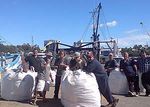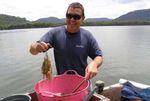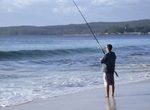The Fishing Industry - Oceanwatch Australia
←
→
Page content transcription
If your browser does not render page correctly, please read the page content below
5. The Fishing Industry Why is the Seafood Industry Important? Seafood is a highly sought after commodity with estimates suggesting up to 90% of Australians eat seafood regularly. The locally produced seafood market for Australia is estimated as being worth approximately $2 billion annually making it fourth highest agricultural earner after beef, wheat and milk. The vast majority of this demand for seafood is supplied by commercial fishers from around Australia who are required to operate under the various jurisdictions and regulations imposed by State, Territory and Commonwealth governments. In 1999 the world’s population reached 6 billion. By 2020 world population is expected to be greater than 7 billion. This will generate increased demand Local snapper, source: OceanWatch Australia for seafood and place greater pressure on all natural resources. In the face of such pressures, the wild harvest and aquaculture fisheries must focus on environmental, social and economic sustainability see www.seafoodtraining.com.au/facts.aboutsfi.html. The seafood industry in NSW is comprised of a variety of businesses that includes commercial fishers, fish farmers and oyster growers as well as a network of wholesalers, marketing and outlets of sale of processed and unprocessed seafood product to the community and for export. Collectively all this business in NSW creates $500 million worth of economic activity each year and employs over 4000 people directly. Commercial fishing within the NSW jurisdiction is currently worth Sorting through prawns caught on the Hawkesbury River, source: more than $90 million dollars at initial market sale. OceanWatch Australia Commercial Fishing in NSW Commercial fishing in NSW is divided into eight different categories or fisheries based on species caught and methods used to catch species. These are: Ocean Haul; Ocean Trawl; Ocean Trap and Line; Estuary Prawn Trawl (in the Clarence River, Hunter River and Hawkesbury River) Estuary General; Inland Restricted (targets carp and yabby mainly in the Murray Darling and Far West) Abalone; and Lobster. For further information see http://www.fisheries.nsw.gov.au/commercial/eight-fisheries Investigate methods of Commercial Fishing, types of seafood http://www.afma.gov.au/information/students/methods/default.htm http://www.afma.gov.au/information/at_a_glance/default.htm OUR VALUABLE ESTUARIES, COAST AND MARINE ENVIRONS-MAKING CONNECTIONS 1
These fisheries are restricted to operating in certain parts of rivers, estuaries and marine environs. For
example, commercial fishing is not allowed in the 30 Recreational Fishing Havens in NSW www.dpi.nsw.gov.au/
fisheries/recreational/your-fees/rfh , (only recreational fishing allowed), nor is it (or recreational fishing) allowed in
certain zones within Marine Protected Areas (MPAs). These MPAs are areas within estuaries (including land
which is inundated by the tides) and the ocean that are protected and maintained to preserve the natural
habitats and biodiversity of the marine environment. These are like marine ‘national parks’ and are managed
by the NSW Marine Parks Authority and the NSW Department of Climate Change. For further information see
www.mpa.nsw.gov.au or http://www.environment.nsw.gov.au/parktypes/TypesOfParks.htm
Potential Impacts of Commercial Fishing
Whilst commercial fishing ensures that we all can enjoy fresh local seafood, commercial fishing can have
some undesirable environmental impacts. These can include:
unintentional catches of non-target species that cannot be sold (bycatch);
over-harvesting of species placing pressure on fish stocks;
disturbance of seabed habitats from fishing gears coming into contact with the seabed (note many areas are
sandy and fishing has no impact);
“ghost fishing”, which refers to the unintentional capture of species that are trapped or entangled in lost or
discarded fishing nets, line, traps etc; and
pollution from wastes including motor exhausts and rubbish.
However, most impacts are managed and thus minimised under the Fisheries Management Strategies and
also through various industry driven initiatives as outlined below. (It should also be noted that some problems
have been created by poor management responses to issues.)
How is the Commercial Fishing Industry in NSW Regulated?
In New South Wales all commercial fishing operations are tightly controlled via the Fisheries Management Act
1994 and Fisheries Management (General) Regulations 2002. The NSW Department of Primary Industries –
Division of Fishing and Aquaculture is responsible for the management and major research related to fisheries
and administers the NSW legislation and compliance with it.
Generally fisheries management is regulated by a combination of controls over input and output.
Input controls limit the amount of effort commercial fishers are able put into their fishing activity and so
indirectly control the amount of fish caught.
This is achieved by regulating such things as:
the number of licensees/fishers in a particular fishery;
net length and mesh size limits that are able to be used;
the size and engine capacity of boats; and
the areas, timing or seasonal closure of certain
fisheries. For example, fishers may request DPI
to close an estuary for a certain period when key
species are breeding. This helps to sustain the
fishery.
Input controls may also include bycatch reduction
devices (BRDs) that have to be attached to nets.
These BRDs either work to allow more small or non-
target fish to escape the through net or to prevent
the capture of important non-target animals like sea
turtles. (Bycatch are animals that are not targeted
by the fisher, which are unintentionally caught and
cannot be sold). One type of BRD which is used by many prawn trawl fishing boats is
the square mesh codend (part of the net where the catch collects).
Investigate bycatch reduction and exclusion devices The square shape of the mesh means it remains open when it is full,
that reduce unwanted bycatch. allowing juvenile prawns and fish to escape, source: OceanWatch
Australia
2 OUR VALUABLE ESTUARIES, COAST AND MARINE ENVIRONS-MAKING CONNECTIONShttp://www.fisheries.nsw.gov.au/commercial/commercial2/
bycatch_and_its_reduction
http://adl.brs.gov.au/fishbycatch/index.php
http://www.afma.gov.au/environment/bycatch/default.htm
http://www.csiro.au/science/ps11j.html
http://www.oceanwatch.org.au/snindex.htm
Output controls directly limit the amount of catch
that can be taken out of the water. This includes set
quotas for a particular species (numbers or weight)
that can be caught in a specified time frame. For
example, a fisher maybe allocated 5 tonnes of a Estuary Prawn Trawl Fishing on the Hawkesbury River, source:
OceanWatch Australia.
certain species that they can harvest in a particular
fishing season.
Regulations controlling different fisheries can be complex having been developed over a long period of time
and with differences in methods and other conditions of licences that vary from region to region.
The Commercial Fishing Industry and Environmental
Sustainability
The commercial fishing industry has been involved in many initiatives to improve their own environmental
performance and also initiatives which seek to improve or protect fish habitat and water quality, all very
important to sustaining wild harvest fisheries. These include:
Wetland Care Australia’s rehabilitation projects http://www.wetlandcare.com.au/;
DPI “Fish Habitat Monitors” – fishers notify DPI of any change to or disturbance of the aquatic environment
and/or to fish stocks;
Environment Management Systems for fisheries http://www.oceanwatch.org.au/snprojectNSW.htm; and
Contributing to the core funding of OceanWatch Australia, a national environmental, not-for-profit company
that works to achieve sustainability in the Australian seafood industry by protecting and enhancing fish
habitats, improving water quality and advancing the sustainability of fisheries through action based
partnerships with the Australian seafood industry, government, natural resource managers, private
enterprise and the community. www.oceanwatch.org.au
The fishing industry also participates and is involved in OceanWatch Australia’s various programs such as:
––“Tide to Table Program” which involves on-ground works to restore fish habitat across coastal
catchments for the benefit of marine life, environment and the seafood industry;
http://www.oceanwatch.org.au/campaignAquatic.htm
––“SeaNet Program”, an environmental extension service to the Australian seafood industry and provides
information and advice on improved fishing gear,
technology and methods;
––“Aquatic Habitat Protection Program” which
provides information and advice to governments,
Natural Resource Management (NRM) managers,
the community and other coastal and marine
stakeholders in relation to NRM issues impacting
on the seafood industry; http://www.oceanwatch.org.
au/campaignNSW.htm
––“Fishing for Waste Program”; and
http://www.oceanwatch.org.au/OceanWatchAustralia-
2007ProgramHighlights.htm
––Introduced Marine Pests. http://www.oceanwatch.org.
au/snprojectVicSeastars.htm
In summary, the commercial fishing industry has Sydney fishermen and bags of old net and line collected as part
recognised that some of its previous practices of OceanWatch Australia’s “Fishing for Waste” program, source:
and even current practices in some areas are OceanWatch Australia
OUR VALUABLE ESTUARIES, COAST AND MARINE ENVIRONS-MAKING CONNECTIONS 3unsustainable. As a result, industry members and associations have adopted new methods and promoted research into various areas of the fishing industry to work out ways to make practices more sustainable. The ongoing livelihood of fishers into the future depends on sustaining a healthy fishery and whilst managing authorities (DPI) have developed regulatory mechanisms, the industry generally adopts an approach that goes above and beyond these regulations. The industry has also been a champion and often a driver for improved ecological outcomes in estuarine and marine environs for all catchment users. Investigate what some of these initiatives are about. Aquaculture Aquaculture is a sector of today’s fishing industry that has in fact been long practised since traditional times by indigenous Australians. In more recent times it has been predominated by oyster growing in NSW but more and more it now incorporates a widening variety of species. Furthermore, with increasing pressures on wild fish and other seafood stocks, aquaculture is being viewed as a way of intensively farming seafood species to supplement the wild harvest. Some of the most common species that are farmed in include: oysters; yabbies; prawns; silver perch; trout; and snapper. Sydney Rock oysters, source: OceanWatch Australia More and more research is being spent on developing aquaculture opportunities in NSW with other species likely to become farmed in the future. Opportunities for indigenous communities to have a greater involvement today in aquaculture industries are being investigated and promoted by NSW DPI. For those wanting to undertake land based aquaculture activities significant safeguards have been built into the approval process due to the potential for these intensive farming practices to have similar catchment/ estuary environmental impacts as other forms of agriculture. Safeguards include prevention of excessive nutrient and other waste outflows and even disease output from fish farm ponds. The positioning of such ponds and the species allowable are also taken into account to minimise risks posed by flood events that might otherwise lead to wastes, nutrients, diseases and even the aquaculture stock escaping to the environment. http://www.dpi.nsw.gov.au/fisheries/aquaculture http://www.australian-aquacultureportal.com/ Specific environmental and health issues and Initiatives of the Aquaculture Industry include: NSW Shellfish Program (NSWSP) - the primary purpose of this program is to ensure that shellfish produced in NSW are of the highest standard; and the http://oysterfarmers.oystersdirect.com.au/qap/index.htm NSW Oyster Industry Sustainable Aquaculture Strategy (OISAS) – this strategy has a number of objectives but primarily relates to ensuring that areas for oyster growing are recognised, given due consideration in planning and other decision making and that due efforts are made to ensure Oyster leases, Clyde River NSW, source: OceanWatch Australia these areas remain viable healthy areas for oyster growing. http://www.dpi.nsw.gov.au/fisheries/aquaculture/publications/oysters/industry/nsw-oyster-industry-sustainable-aquaculture-strategy 4 OUR VALUABLE ESTUARIES, COAST AND MARINE ENVIRONS-MAKING CONNECTIONS
Oyster Industry in NSW http://www.dpi.nsw.gov.au/fisheries/aquaculture/publications/oysters/industry/oyster-industry-in-nsw Sydney Rock Oyster Fact Sheet http://www.dpi.nsw.gov.au/fisheries/aquaculture/publications/oysters/oysters/diseases-of-sydney-rock-oysters Diseases of Oysters http://www.dpi.nsw.gov.au/__data/assets/pdf_file/0004/164182/Diseases-of-Sydney-rock-oysters.pdf http://www.dpi.nsw.gov.au/fisheries/aquaculture/publications/oysters/oysters/diseases-of-sydney-rock-oysters QX disease http://www.dpi.nsw.gov.au/fisheries/aquaculture/publications/oysters/oysters/qx-oyster-disease Fish Diseases and Human Health http://www.dpi.nsw.gov.au/fisheries/aquaculture/publications/health/fish/fish-diseases-and-human-health Depuration http://www.dpi.nsw.gov.au/research/areas/production-research/aquaculture/outputs/1999/depuration-shellfish Recreational Fishing One in four people participate in recreational fishing in NSW. These people, i.e. recreational fishers, spend substantial sums of money carrying out their interest/sport and this expenditure is highly significant to regional economies where recreational fishing popularly occurs. Between 2005 and 2006, it was estimated that recreational fishers in NSW spent more than $550 million on fishing related items such as fishing gear and a variety of other less easily defined items such as camping gear, boat accessories etc. Recreational fishers in NSW use a variety of capture Beach fishing, NSW, source OceanWatch Australia methods to catch more than 200 varieties of fish species, with approximately 30 species making up the bulk of the catch. For most of these species commercial fishing catches are greater than the recreational catch for that species but for several common species the opposite was true. Nevertheless the total fishing effort by recreational fishers is substantial with significant impact on aquatic resources. http://www.dpi.nsw.gov.au/archive/news-releases/fishing-and-aquaculture/2004/19_apr_04_-_how_much_is_recreational_fishing_ worth_to_coastal_towns http://www.dpi.nsw.gov.au/fisheries/recreational/publications/general/Survey-of-Recreational-Fishing-in-New-South-Wales.pdf http://www.asfb.org.au/pdf/1994/1994-00-01.pdf http://www.asfb.org.au/pdf/1994/1994-04-02.pdf http://www.asfb.org.au/pdf/1994/1994-04-04.pdf Investigate the most common recreational fish caught and the method most commonly used to catch it. Find out about the species life cycle and the importance of estuaries to it. http://www.fishnames.com.au/ http://www.marine.csiro.au/caab/standard_names.htm http://www.marine.csiro.au/caabsearch/caab_search.fish_ names_list http://www.seafoodservices.com.au/ http://www.frdc.com.au/shop/merchant. mvc?Screen=SRCH&Store_Code=photo Recreational fishing at Tathra NSW, source: NSW DPI OUR VALUABLE ESTUARIES, COAST AND MARINE ENVIRONS-MAKING CONNECTIONS 5
Potential Impacts of Recreational Fishing on
the Environment
Recreational fishing can have some undesirable impacts
on the environment. These activities and their impacts
can include:
catching undersize fish i.e. catching too many baby
fish which have not yet had a chance to breed;
over-harvesting of species placing pressure on fish
stocks;
leaving behind fishing line and tackle and dumping
rubbish, which can entangle animals causing either
Littered fishing line which can entangle pelicans and other
injury or death, marine life, source: OceanWatch Australia
motoring at high speeds in narrow waterways,
creating boat wake which erodes riverbanks; and
motoring through seagrass beds, damaging or destroying the fragile fish habitat.
How is Recreational Fishing Regulated?
The recreational fishing industry is divided into two sectors; a freshwater inland component and a marine and
coastal estuary component. Both of these sectors are regulated by licences from the NSW Department of
Primary Industries (DPI) – Fishing and Aquaculture. This means that anyone who wishes to go out and catch a
fish must buy a license beforehand.
http://www.dpi.nsw.gov.au/fisheries/recreational/licence-fee
There are special rules and regulations surrounding where you can fish, the sizes of fish you can keep, where
you can collect bait, the methods you are allowed to use to catch fish and collect bait. However, unlike
commercial fishing, there has not been any detailed assessment of the environmental impacts of recreational
fishing in NSW or any management strategies put in place to deal with these impacts.
http://www.dpi.nsw.gov.au/fisheries/recreational/regulations
Investigate the rules surrounding recreational fishing, what is an Intertidal Protected Area or IPA, what are the
rules about bait collecting.
http://www.dpi.nsw.gov.au/fisheries/closures/general/invertebrates-ipa
http://www.fisheries.nsw.gov.au/marine_protected_areas/ipa
http://www.fisheries.nsw.gov.au/__data/assets/pdf_file/0015/5055/Habitat-Protection-Plan-Hawkesbury.pdf
Recreational Fishers and Sustainable Fisheries
The recreational fishing industry is also involved in a number of initiatives aimed at benefiting the sustainability
of the fishery or reducing their impact on the environment. These include:
OceanWatch Australia’s “TAngler Bin” project. http://www.oceanwatch.org.au/TAnglerBinProject1.htm
RecFish Australia’s “Catch and Release” Program
The NSW DPI Fishing and Aquaculture Recreational Fishing Trust (Saltwater Trust and Freshwater Trust) also
funds a variety of initiatives that are aimed at educating and promoting recreational fishing in a sustainable
way. (The funds collected from recreational fishing licences are pooled into this Trust and spent on things
which improve recreational fishing in NSW).
http://www.dpi.nsw.gov.au/fisheries/recreational/your-fees/
6 OUR VALUABLE ESTUARIES, COAST AND MARINE ENVIRONS-MAKING CONNECTIONSWhat Are the Main Environmental Issues Affecting the
Fishing and Seafood Industries?
There are some major environmental issues that affect the fishing industry and its seafood products. The
industry is dependent on healthy coastal aquatic habitats and good water quality which can be threatened by
the following:
Disturbance and destruction of important nursery
areas for baby fish and crustaceans such as wetlands,
mangroves, saltmarsh and seagrass beds:
––Degradation can be caused by inappropriate
development in these habitats, recreational use
which damages plants and soils or invasion by
weeds.
Pollution of waterways from urban stormwater, farm
runoff, industrial discharges or illegal dumping of
chemicals:
––Toxins can accumulate in food chains and become
more and more dangerous for humans to consume
and may actually kill aquatic animals such as fish. Cleared riverbanks showing signs of erosion, Clarence River
NSW, courtesy of DECC
––In some areas in NSW, whole oyster production
areas have become contaminated by water pollution
and have had to shut down their production.
Disturbance of acid sulfate soils can cause acid and heavy metal contamination of waterways and wetlands:
––This can cause fish to become vulnerable to diseases and parasites or may result in massive fish kills.
––Disturbance is usually caused by development of land for housing, industry, agriculture or drainage works.
Degradation or removal of riparian vegetation, mainly as a result of clearing, grazing and weed invasion:
––
This damages fish habitat in many ways and can lead to fish population decline. Riparian vegetation is
very important for fish and fish habitat as it provides shade, bank stability and hosts thousands of insects
and bugs which are food for fish. Bank vegetation also provides fallen branches which fish and other
species use to shelter under and spawn.
Climate change impacts:
––Plants and animals can mostly only tolerate small changes in water temperature and chemistry. Climate
change may cause changes that aquatic plants and animals cannot tolerate. As seagrass, mangrove and
saltmarsh habitats decline due to climate change, so will many of our commercial seafood species.
Sources of Additional Information
http://www.afma.gov.au/information/publications/education/default.htm
http://www.afma.gov.au/information/students/game.htm
http://www.afma.gov.au/information/maps/default.htm
http://www.afma.gov.au/information/glossary.htm
http://www.asic.org.au/related.sites.html
http://www.frdc.com.au
Turtles http://www.environment.nsw.gov.au/surveys/MarineTurtleSurvey.htm
Sea Grass http://www.frdc.com.au/bookshop/seagrass_research.pdf
http://www.seafoodtraining.com.au/facts.aboutsfi.html
http://www.oceanwatch.org.au/
http://www.asfb.org.au/
http://www.asic.org.au/related.sites.html
Seafood Training Australia (STA) (2007) - Facts about the Australian seafood industry
http://www.seafoodtraining.com.au/facts.aboutsfi.html
Fisheries Research and Development Corporation http://www.frdc.com.au/
OUR VALUABLE ESTUARIES, COAST AND MARINE ENVIRONS-MAKING CONNECTIONS 7You can also read



























































